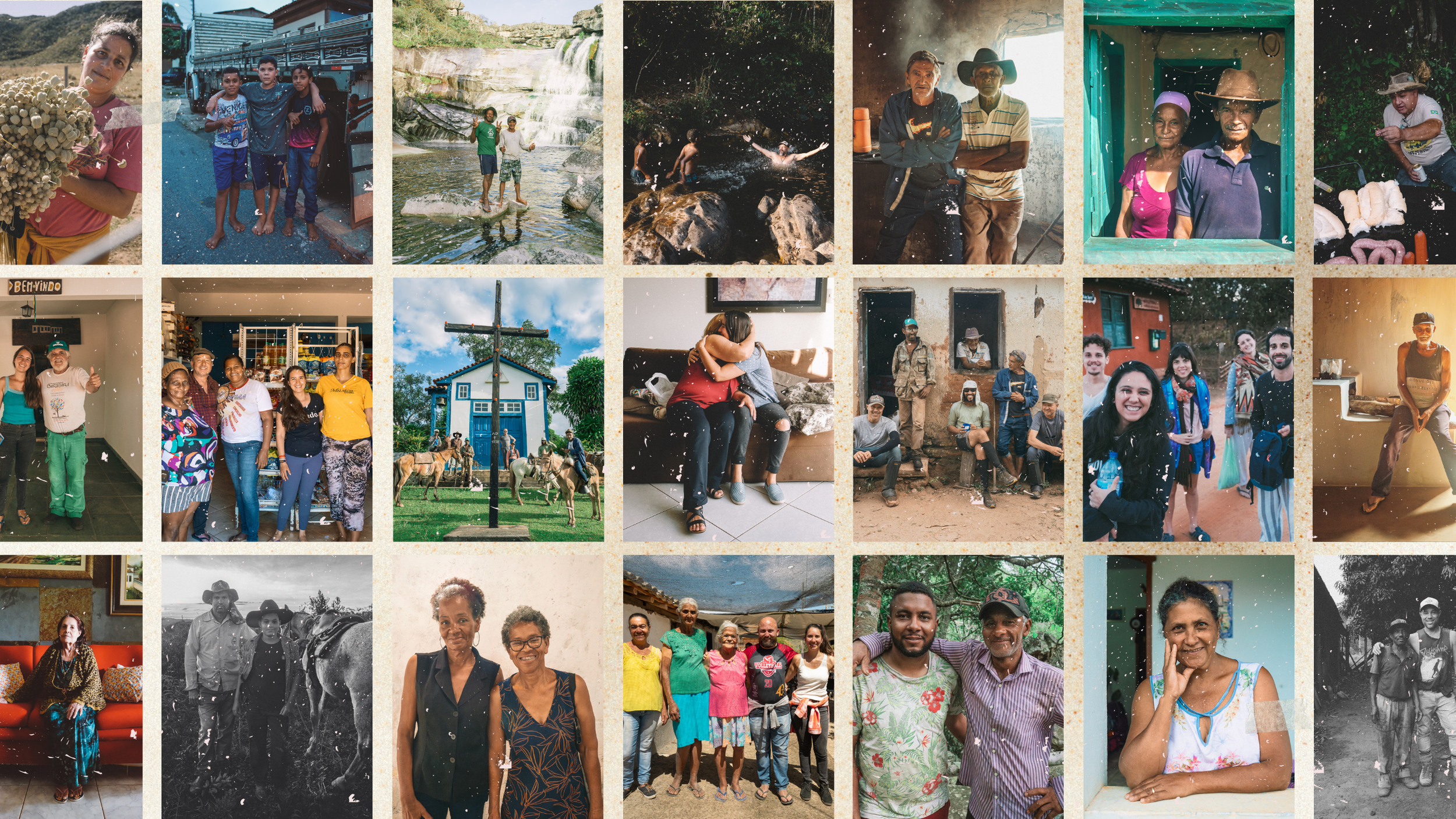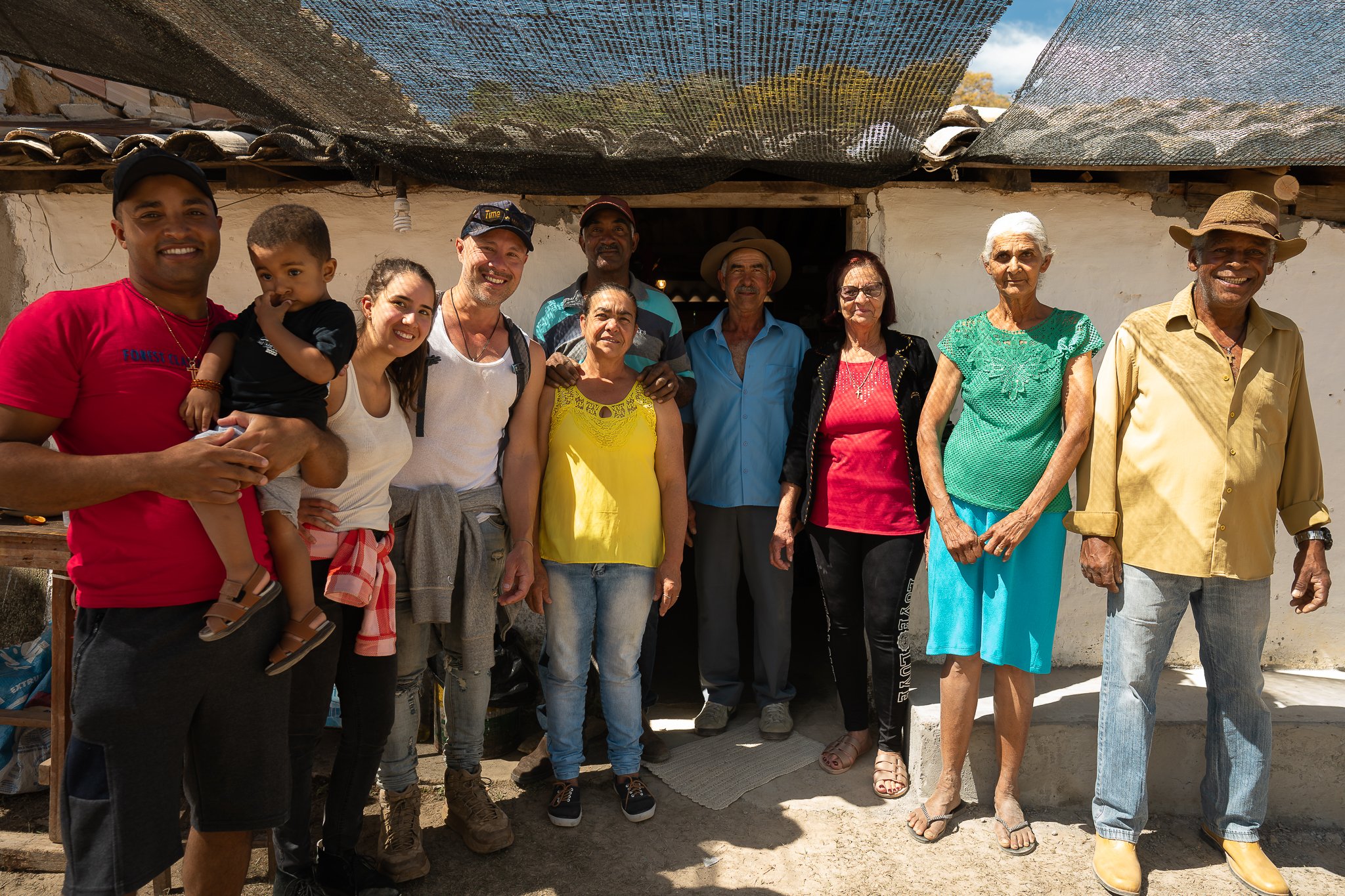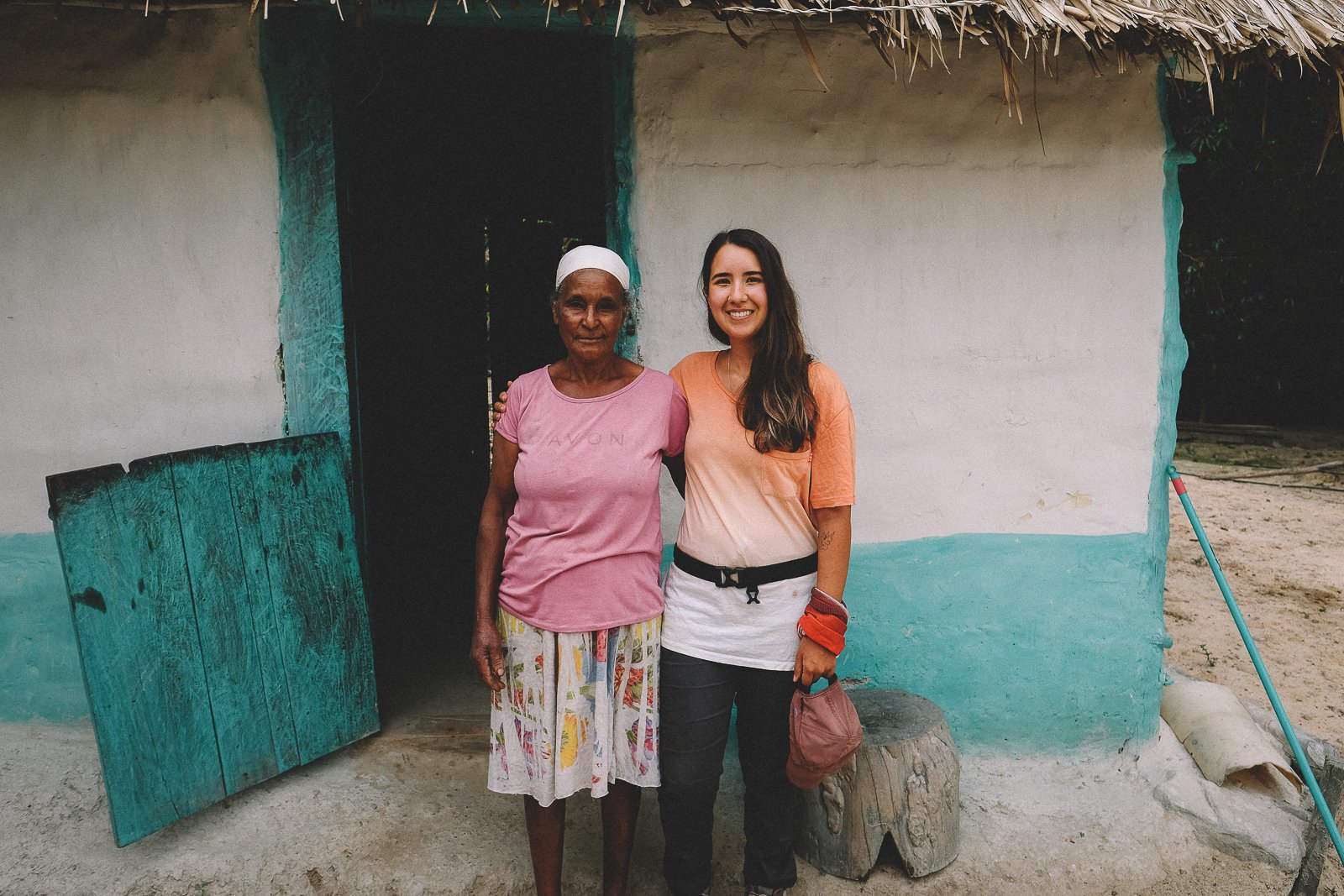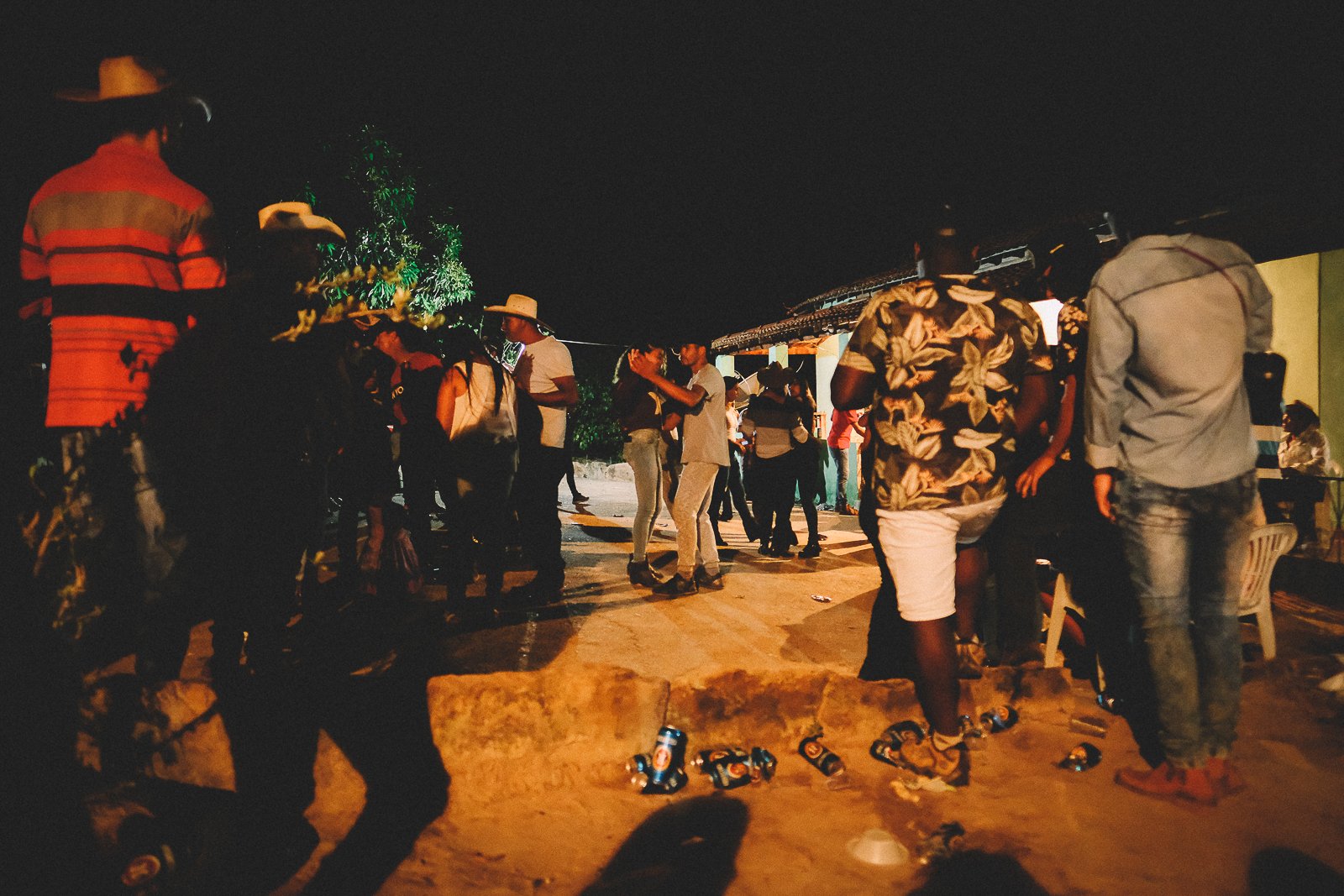
Give by Going
unlocking the transformative power of travel
.“We make a living by what we get. But we make a life by what we give.”
- Winston Churchill

Why We Do This. 2023
I.
Community is a journey
It sounds so naive today, but looking back, Elisa & I never imagined that community would play such an enormous part of our lives. We were determined to share the stories of places we felt deeply drawn to, but the truth is that we had no idea what that would require from us professionally, let alone on a personal level. We simply set out and made our way, step by step, learning as we went.
Today, we know that many of those steps have in fact been relationships, and that our journey all along has been community.
Looking back, it all makes sense. After all, there is no better way to tell a story than to be a part of it.

Teacher & Student / I miss you, Levi. 2022
II.
What It looks like in Practice (i.e. The tangible benefits of going)
One of the best parts about owning a business is that you get to make the rules yourself.
Here’s how our philosophy plays out on the ground:
We contract exclusively with local individuals & businesses, including those in the remote communities we visit, with the intention of stimulating economies via genuine, non-intrusive visitation. If there’s a way to train & hire a resident, we do it.
We pay above-market wages. Some of the men & women on our crew earn more during a few days on the trail with us than they typically earn in a month, while our full-time team earns well above national averages for similar work. Should you join us on a trip, we’re confident you’ll agree they’re worth every penny.
We prioritize family-owned accommodations, some of which had never hosted guests before. One night on our route on our can equal (and in some cases, surpass) a month’s income for a household, while others are able to meaningfully complement their existing income.
We go out of our way to support micro-enterprises whenever possible, sometimes going to great lengths in order to contract—and train—for even the “smallest” of tasks. Examples of this include contracting local women in rural communities to make trail lunches & snacks; training local men to assist travelers as porters; and contracting local taxis for overland transfers. There are certainly easier ways to handle these tasks, but none are better.
We fund and lead R&D expeditions to underexplored areas with ecological & cultural value. We then share our findings with community stakeholders — uniting unlikely teams of scientists, environmentalists, land owners, students, small business owners, and government officials in the process. Our ongoing study of Sempre Vivas National Park, for example, has led to multiple new touristic routes within the Park, as well as Park jobs for a handful of crew members whom we trained during R&D expeditions.
We amplify regional identity by documenting residents’ lives and advocating for a shared cultural patrimony. Subsistence farmers, flower-pickers, miners, and academics alike each have a role to play in the Espinhaço’s unfolding story.
We raise awareness within communities about the ecological & cultural resources they possess, and support them in protecting their heritage. We believe that community-based tourism & ecotourism have the potential to meaningfully complement traditional extractive economies in decline, particularly in smaller, isolated communities.
We maintain trails in local conservation units, picking up discarded items and (upon permission and/or request) selectively clearing vegetation along pathways—several of which still serve as vital passageways for remote households.
We sponsor personal projects that celebrate & honor the places where we work. Eddie’s upcoming photo journal documenting the backcountry communities of the Serra do Espinhaço, “The View Strikes at Once”, co-sponsored by Diamantina’s Department of Tourism, is one example of this. We also hope to co-sponsor a documentary about the region in the coming years.
We donate 5% of all trip proceeds towards a variety of local causes, projects, and organizations that we know personally and vouch for, all of which contribute meaningfully to lives & nature in the places we go.

Barbosa & Lúcia, Community-based tourism pioneers in Inhaí.
III.
The process of becoming part of something greater
Since September 2021, Elisa & I have spent just about every waking moment of our lives studying, documenting, and traveling in Brazil’s Serra do Espinhaço, to the point that if we previously had other lives, I don’t remember them. We spend our weeks working from our home outside of Diamantina, cooking for friends & neighbors, and taking Luca back & forth to school (and to band practice, and to basketball tournaments, etc.); our weekends visiting friends in the tiny districts that line the dirt roads of the front country; and family vacations with Luca & Tiago trekking across the range to visit yet other friends further afield. Meanwhile, our R&D process continues to inevitably—and thankfully—fill our lives with countless new, unexpected and enriching relationships with residents from all walks of life.
On one hand, it’s all part of the job; the time, energy, and resource investments necessary to get to the bottom of the incredible, untold story that we want to share with travelers. On the other hand, it’s our whole lives; we’ve literally given the Espinhaço everything we have to give.
In turn, the journey has filled our lives with unexpected joy, meaning, and relationships. At some point, “giving back” stopped feeling like a dutiful act of corporate goodwill and began feeling like what it is: an act of good neighborliness — the natural consequence of caring deeply for a place & wanting to see it succeed.

First Trip to Dona Maria’s Home. 2021
IV.
The Real Questions
Elisa & I stopped worrying long ago about whether our trips would positively impact the Espinhaço & its residents. The answer to that became clear during our first 30-day trek across the region, when we witnessed first-hand how transformative community-based tourism could be economically for the individuals & households we work with.
Four years—and 11 multi-week treks—later, and we’ve never been more confident that working directly with residents creates a more enriching, unforgettable experience for travelers.
We know that the best trips enrich the lives of all who are involved.
The questions today have become: “can we do more?” and “why settle for less?”

Best Party Ever. 2021
V.
The (overrated) Power of Resources
It’s no secret that building strong communities requires vision, commitment, resources, and time. Yet it’s so easy to overestimate the importance of resources—especially financial ones—to the equation.
Contracting local services is the starting line, not the finish.
Donations are powerful—but without vision, commitment, and a long view, even large sums can disappear into the ether (we have personally witnessed large sums of money accomplish shockingly little).
At the end of the day, while money is essential to building just about anything, it seems uncontroversial to suggest that providing enterprising individuals & households with the tools & knowledge to choose and create their own livelihoods is far more empowering, more valuable, and more sustainable than even the most generous donation could ever be.

Luca & Júlio. 2024
VI.
the 5%
During our time in the Espinhaço, Elisa & I have learned that the most meaningful & satisfying contributions are the ones that combine money with presence, trust, and long-term effort.
The fact that we live here and travel the region frequently for research & development (a process that always reveals new realities & challenges) not only makes these types of contributions possible—it means our giving can be personal.
We know many of the residents within the communities where we work. We visit their homes, and we invite them into ours. We ask lots of questions (to the point that we’ve earned a very apt nickname: “the Researchers”) and we listen to the answers.
Out of all that listening, we’ve created a running list of “dreams, needs, plans, and projects” across the Espinhaço. Some of the items on the list are small and symbolic. Others are large and transformational.
What they all have in common is that they’re real. And we believe 5%—allocated with care—can make a lasting difference.

The Boarding School. Conselheiro Mata
VII.
Dreams, Needs, Plans & Projects: Where the 5% Goes
5% of proceeds may seem like a modest figure when it comes to making real change, but in a region as isolated as the Espinhaço, every dollar counts—and exponentially more so when that sum is thoughtfully allocated. We keep a running list for both our own sake (sometimes you realize something in the field, but don’t come across that idea again until your next visit 100 days later) and so that travelers can learn a bit more about where their 5% contributions might go.
Here, in loosely broken down categories, are the dreams, needs, plans, and projects currently on our list.
Ongoing Commitments / Donations
Instituto Biotrópicos. The Serra do Espinhaço wouldn’t be the natural wonderland that it does today without the visionary efforts & studious initiatives of Biotrópicos, a local non-profit dedicated to documenting & protecting the region’s immense trove of biodiversity. Whether in the field or on their laptops in Diamantina, the organization’s staff of natural scientists, social scientists, and administrators work around the clock on issues regarding conservation, public education, and economic opportunities for gateway communities. Elisa & I have would like to donate a percentage of GOGO’s proceeds towards Biotrópicos’ general fund for projects in the region.
Esféra Consultoria. One of the most serendipitous things to happen to Elisa & I on Field Trip #8 was meeting André Jordani, owner of tourism consultancy Esfera in Belo Horizonte, and longtime visitor of the Espinhaço. Since February 2024, we have met regularly with André to improve GOGO’s operation in nearly all regards: from safety & emergency response planning to daily logistics to best practices for working with Parks, municipalities, and communities, and the results have been beyond what we could have hoped for. We would like to contract Esfera to work alongside of us and professors of Tourism at Diamantina’s Universidade Federal dos Vales do Jequitinhonha e Mucuri (UFVJM)to construct regional & community-specific sustainable tourism management plans, and to provide training & consulting to entrepreneurial households & individuals interested in community-based tourism.
PAES. If you come on one of our trips (and aren’t allergic to nuts), you’ll almost assuredly take note of the delicious, chunky peanut brittle we carry on the trail, which we order from the Associação de Pais e Amigos dos Excepcionais de Diamantina (“PAES”; Association of Parents & Friends of the Exceptional), a Diamantina-based non-profit dedicated to improving the lives of special needs individuals across the region. Elisa & I live nearby the seat of this well-run, much-needed, and under-funded organization, and would like to donate a percentage of GOGO’s proceeds towards PAES’ general fund for projects in the region.
Micro Projects ($2,500 - $10,000 USD)
Metal cattle grids, Angu Duru. Residents of tiny, enchanting Angu Duru (pop. < 10) must open & close 9 poorly constructed cattle gates along a 20-km dirt road in order to reach São Gonçalo do Rio das Pedras, complicating access to health care & supplies. We would like to purchase & install metal cattle grids to replace the cattle gates.
Metal cattle grids, Santa Rita. Residents of tiny Santa Rita (pop. < 12) must open & close a dozen poorly constructed cattle gates along the treacherous 30-km dirt road to neighboring Burití do Claudio, severely complicating visitation. We would like to purchase & install metal cattle grids to replace the cattle gates.
Soccer field improvements, Quarteis do Indaia. Children outnumber adults in the tiny quilombola community of Quarteis do Indaia (pop. < 25), yet there are no established recreational areas. Residents currently gather to play soccer on a makeshift field in the center of the village, but regret the lack of goalposts. We would like to buy them goalposts, and to help level the terrain of the field.
Bridge, Rio Capivari. In addition to the afore-mentioned cattle gates, the tiny agricultural community of Angu Duru is seasonally cut off from neighboring São Gonçalo do Rio das Pedras (pop. 1,800) by the Rio Capivari, leaving family members stranded during the rainy season (October - March). We would like to commission the building of a bridge (or other solution, such as a steel cable zip line) capable of transporting residents from one side of the river to the other during seasonal floods.
Footbridge, Riberão do Inferno. There are few contaminated water sources in the Espinhaço, but those that exist present significant challenges for rural residents. Residents living in the remote area between Curralinho (pop. 628) & Capão Maravilha (pop. < 10) currently have to cross knee-high contaminated water in the dry season (from April - September) and waist-high water during the rainy season (from October - March). We would like to commission the building of a bridge (or other solution, such as a steel cable zip line) capable of transporting residents from one side of the Riberão do Inferno to the other during seasonal flooding.
Solar battery, Sempre Vivas National Park. Sr. Dorico, one of 4 individuals currently residing within Sempre Vivas National Park, maintains the traditional flower-picker lifestyle of his ancestors. He is a cultural patrimony all to himself, yet his wattle & daub home lacks electricity, his federal government-supplied solar power battery having been stolen many years ago. Without refrigeration, he must walk approximately 10 miles through the mountains to the nearest settlement outside of the Park—a trek that has become more difficult given his advanced age. He has requested help, and we would like to buy him a new battery and create a safe place for it, so that thieves can’t rob him of this basic need again.
Radio repeaters, various locations. Prior to obtaining satellite communications devices, one of the most precarious things about GOGO’s field work was our inability to reliably communicate with local authorities while in the backcountry. As it were, many rural households continue to be completely incommunicable, while the region’s mountainous topography often prevents firefighters & Park personnel from being able to respond quickly to wildfires. We would like to purchase repeaters and install them on prominent local peaks so that both our crew and local response teams can access 2-way radio frequencies in cases of emergency. We would also like to buy 2-way radios for the region’s most remote rural dwellers.
Signage, various locations. As avid trekkers who cherish wild places, Elisa & I have mixed feelings about visible signs of human presence along trails, but we also understand how creating educational & recreational opportunities within State & National Parks can help preserve those Places and drive local economies in gateway communities. We would like to create signage for Park visitors along the main east-west thoroughfare in the Park, from Curimataí to Inhaí. This would offer trekkers a chance to experience one of the most beautiful stretches the Park, while leaving the vast majority of historic trails unmarked.
Small Projects ($10,000 - $25,000 USD)
Establish Visitor Centers, 4 locations. In an effort to create a shared patrimony across the region while recognizing the historic contributions of individual communities and contributing meaningfully to rural economies in decline, we would like to establish visitor centers in four distinct and culturally rich—yet underserved—villages: Mendes, Galheiros, Macacos, and São João da Chapada. Each center would be staffed by locals, serve as a point of pride, and help preserve the distinct stories that make these communities extraordinary. We estimate the cost of each center, including real estate, to be approximately $25,000 USD.
In Mendes (pop. < 5), a nearly forgotten ranching outpost, we hope to restore the town’s former rail station as a weekend visitor center and modest museum—offering trail snacks, refreshments, and a glimpse into its pastoral past.
In Galheiros (pop. < 25), a remote flower-picker village globally recognized by UNESCO for its agricultural heritage, we would like to create a center that honors its legacy. It would feature a Flower Picker Heritage Museum and a storefront for artisan crafts, staffed by local residents.
In Macacos (pop. < 15), a quilombola village on the border of Sempre Vivas National Park, we aim to establish the Park’s de facto southernmost visitor hub. This center would preserve and present the flower-picking traditions of its residents, who’ve stewarded the fields for generations.
And in São João da Chapada (pop. 1581), a soulful colonial-era district once central to Brazil’s diamond rush, we hope to restore a historic home in the city center to serve as its first official visitor center—housing a museum of mining and floral heritage alongside a small crafts market.
Infrastructure improvement, 2 State Parks.
Beautiful Itambé State Park receives 3,000 visitors each year, yet lacks basic infrastructure outside of a single concrete guest house atop the region’s highest peak. We’ve been asked to support the creation of restrooms on the lesser-served eastern side of the park, where visitor amenities are nonexistent. We would also like to contribute to the opening of a pair of historic trails that have remained closed due to overgrown vegetation & lack of signage.
At Rio Preto State Park, widely regarded as one of the region’s most exemplary protected areas, time and exposure have taken their toll: sun-bleached signs, closed observation decks, rope bridges in disrepair, poorly marked trails. We’re committed to helping restore and improve these features—and to working with the park’s leadership to identify other meaningful ways we can contribute.
Create additional lodging, Bica d’Agua. Sr. Santo & Dona Maria are two of the last remaining residents in the remote valley of Bica D’Agua, and the lone residents able to receive visitors at their home. We would like to purchase a plot of land adjacent to Sr. Santo; donate it to him; and contribute to the construction of additional shelters & restrooms on it, so that future guests—including our own—don’t overwhelm his current facilities.
Mid-Sized Projects ($25,000 - $100,000 USD)
Launch a Fine Art Gallery in Diamantina. Though recognized as a UNESCO World Heritage Site, Diamantina currently has no dedicated fine art gallery to showcase local talent. We’d like to purchase and restore a small historic home in the city center to create the town’s first permanent gallery—featuring rotating exhibitions of regional paintings, sculptures, photographs, and other works. The gallery would be conditionally donated to a local nonprofit (yet to be determined). We’re also exploring the idea of a traveling exhibition circuit, bringing curated pieces to rural districts on a rotating basis—both to spotlight local artists and deepen a shared regional identity.
Build a Recreation Center in Diamantina. Despite being home to over 50,000 residents, Diamantina has just two public recreation centers, both in disrepair—one of which will be closed for restoration for the next two years. Still, these under-resourced spaces remain vital gathering points for the city’s children and teens. We’d like to build a third center, designed with infrastructure for soccer, basketball, volleyball, and handball, as well as table tennis, chess, and other activities. We also hope to support upgrades to the city’s two existing centers. The new facility would be donated to the City of Diamantina.
Large Projects ($100,000+)
Establish Visitor Center & Lodging, Sempre Vivas National Park. Sempre Vivas National Park is vast—larger than Greater Los Angeles—and almost completely uninhabited. It’s the crown jewel of the Espinhaço’s conservation mosaic and the second largest protected area in Brazil’s Cerrado biome. Yet for 23 years, a lack of funding has prevented the federal government from purchasing key lands within the Park, leaving the area little known, rarely visited, and effectively inaccessible—while simultaneously prohibiting traditional land use by the neighboring communities who once depended on it. We’d like to purchase and restore Taquaral, a sprawling, long-abandoned ranch deep inside the Park, and turn it into the Park’s first official Visitor Center and wilderness refuge. The center would provide basic accommodations and facilities for travelers and Park staff, be managed in partnership with ICMBio, and be staffed by residents from surrounding communities: Macacos, Inhaí, Quarteis do Indaiá, Santa Rita, and Curimataí.
Establish Education Center, Conselheiro Mata. For generations, the boarding school in Conselheiro Mata (pop. 200) was celebrated regionally for its commitment to academic excellence. Today, the school is crumbling, vandalized, and scarcely used. We aim to restore the school and transform it into a regional education center, offering courses in tourism, English, business, entrepreneurship, art, history, and public policy. The school would be conditionally donated to the City of Diamantina and governed by a local board that includes leaders from the Conselheiro Mata Community Association.
VIII.
The Journey Ahead
Back in September 2021, Elisa & I never imagined that community would play such an enormous part of our lives. Yet here we are, four years later—right in the middle of it.
We don’t pretend this is the answer. But we do know it’s a start.
Giving back to places that have given us so much feels like the least we can do.
Travel should be a gift for everyone involved.
And if we’re going to go, this seems like the right direction.
Want to see where all of this comes to life?
Step inside one of our journeys.
If you’d like to go deeper, you can also meet our crew, learn about our philosophy, or read stories from the trail.

“Wherever you stand, be the Soul of that place.”
